Contents
Market Overview
Macro Review
Inflation rose to a 40-year high. U.S. Treasuries widened “gradually, then suddenly” as Hemmingway would put it. That holds for the 2-year U.S. Treasury that widened 20 bps, reflecting its largest one-day move since 2009 to above 1.50%. The extreme volatility moved Eurodollar futures sharply as the 10-year note broke above the 2% and one-year inflation swaps traded above 4%. Indeed, U.S. Treasury curves continued to flatten as 2s10s moved down to 39 bps, just as 7s10s inverted as an alarming recession barometer. This is further evidence that the Fed remains behind the curve and as such, it triggered an emergency meeting. The market is now pricing in 41 bps for the March FOMC, with the continued hype of a 50 bps hike given comments from the Fed’s Bullard last week. The impact on equities was also vigorous but brief, as U.S. equity bourses closed broadly flat on the week. On the other hand, EM fared far better. The MSCI EM ended the week up 2.4% with equities out of Peru (+8.9%), Chile (+6.9%) and Russia (+6.5%) outperforming. However, it wasn’t just U.S. inflation that caused alarm with red hot releases out of Mexico, Chile, and Colombia. The tightening cycle in EM therefore remains active with 50 bp hikes from Peru, Poland, and Mexico, and then 100 bps from Russia, although India surprised by keeping rates unchanged. India’s dovish surprise came as the market was hopeful of a 20 bp increase. Finally, the Normandy Format talks ended without agreement, while the Foreign Secretaries of Russia and the UK ended in a barbing exchange rather than any constructive developments. These factors contributed to Russia’s CDS sharply underperforming on Friday as it widened more than 40 bps to above 220 bps.
EM Credit Update
Emerging market sovereign credit ended the week down 0.5%, with credit spreads tightening 6 bps. In the aftermath of the U.S. inflation release, U.S. Treasuries widened between 4 bps in the long-end and 27 bps in the shorter tenors, as the front-end of the curve was under notable pressure. With flatter curves, occasional curve inversion and higher real yields, EM navigated the macro uncertainty in good order. EM hard currency has only seen moderate outflows of $1bn through February, with local currency inflows of $600m, which is holding up well relative to developed markets credit. Outperformers over the week were El Salvador, Ethiopia and Honduras, while Tunisia, Slovakia and Zambia underperformed.
The Week Ahead
FOMC minutes remain the key event next week, along with the emergency Fed Board of Governors meeting on Monday. We could perhaps expect further BOJ intervention to support its 0.25% target on the 10yr JGB too. Given the high U.S. inflation print, the UK is similarly set to post a high reading, even after the December release rose at its fastest pace since 1982. Within EM, Turkey’s Central Bank decision comes as soon as Thursday (14.0%), with other rate decisions from the Philippines (1.5%) and China’s MLF rate (2.85%). Brazil will also publish Copom minutes, with the expectation of providing clarity on its interest rate path ahead as the tightening cycle is expected to moderate from May. Thereafter, inflation releases out of Argentina, China, Czech Republic and India are due, with GDP out of Colombia, Hungary and Israel.
Highlights from emerging markets discussed below include: Peru undergoes another cabinet reshuffle as political volatility remains elevated, China credit growth shows signs of improvement on looser policy stance, Angola and Ghana see divergent ratings adjustments, Sri Lanka’s Central Bank constructive on sovereign’s ability to service upcoming debt obligations, and global emerging markets corporates in focus: beware of rate rises?
Fixed Income
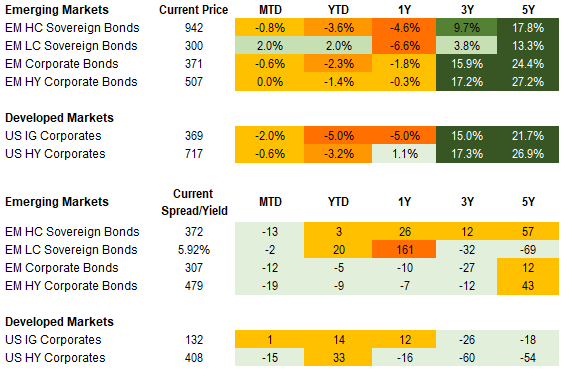
Equities
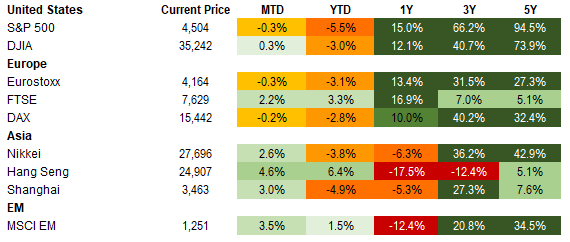
Commodities

Source for data tables: Bloomberg, JPMorgan, Gramercy. EM Fixed Income is represented by the following JPMorgan Indicies: EMBI Global, GBI-EM Global Diversified, CEMBI Broad Diversified and CEMBI Broad High Yield. DM Fixed Income is represented by the JPMorgan JULI Total Return Index and Domestic High Yield Index. Fixed Income, Equity and Commodity data is as of February 11, 2022 (mid-afternoon).
Emerging Markets Weekly Highlights
Peru undergoes another cabinet reshuffle as political volatility remains elevated
Event: President Castillo swore in a new Premier of Ministers following Hector Valer’s resignation late last week after just four days in the post. Six other ministers were replaced, but the market relevant Economy and Finance Minister remains unchanged for now with comparative technocrat Oscar Graham retaining the position. Absent further changes, Congress now has 30 days to approve the cabinet which requires 66 out of 130 votes. Meanwhile, the Central Bank hiked rates another 50 bps to 3.5% in line with expectations. This improves the real policy rate to -220 bps following last week’s inflation dip.
Gramercy Commentary: We see the very short-lived nature of the last cabinet as further indication of Castillo’s inability to source talent and manage deep political tensions amid a divided Congress and ruling party. We think that Congress will want to avoid dissolution, which occurs after two failed confidence votes on the cabinet or other matters, although it remains unclear if this cabinet composition is adequate for approval. The momentum for presidential vacancy is likely to build as the year progresses. In the meantime, we expect the government to come to market once a period of temporary political stability is reached and BCRP policy to remain on a path to normalization.
China credit growth shows signs of improvement on looser policy stance
Event: In January, total social financing ticked up to 10.5% y/y from 10.3% in December while the credit impulse also improved, though it remained in negative territory. M2 money supply also grew at a faster than envisaged pace of 9.8% y/y versus market consensus of 9.2% y/y. The data reflect strong performance in local government bond issuance on the back of front-loading as well as increased corporate bond issuance and short-term financing. However, long-term household loan growth remained weak in the backdrop of depressed home sales.
Gramercy Commentary: The incremental improvements are positive for the outlook for broader economic activity and in line with our expectations that credit weakness bottomed in late 2021 and should gradually improve throughout 2022 on moderately looser policy. While property market dynamics and regulations pose challenges for the household sector, recent easing by PBoC and CBIRC on the loan caps to the property industry via exemption of affordable housing loans should provide a boon for lending in that space. More broadly, we see room for additional easing including RRR cuts, targeted property measures, and to a lesser extent policy rate cuts, if data disappoint.
Angola and Ghana see divergent ratings adjustments
Event: S&P upgraded Angola’s ratings one notch to B- with a stable outlook on the back of improved fiscal and external performance supported by the recently concluded EFF program with the IMF as well as elevated oil prices. This follows a similar upgrade by Fitch last month. Conversely, Moody’s lowered Ghana’s ratings one notch to Caa1 with a stable outlook on the back of external funding pressure and rising debt levels. This follows Fitch’s outlook revision to negative on its B- rating earlier in the year. Ghanaian government officials have announced disagreement with the Moody’s action and intend to pursue an appeal.
Gramercy Commentary: In Angola, we see the action as aligned with our view that the government will largely stay the course in terms of policy execution despite electoral considerations and lack of an IMF anchor this year. With over 90% of export receipts from oil, our constructive view on the oil market significantly anchors our benign near-term assessment of the financial position of the government. In Ghana, we see the directionality of the rating momentum as unsurprising given the recent heightened fiscal uncertainty in the context of higher external rates and structural credit constraints. While we see merit in the government’s frustration over the Moody’s downgrade as it further complicates the near-term challenges of restoring market confidence and alleviating external financing pressures, we do not expect any near-term change in the rating decision despite the appeal. We think there is room for eventual agreement on a watered-down e-levy and expenditure restraint combined with actual 1H fiscal performance which could provide support to asset prices. We believe recovery of the rating loss will require confirmation of more durable fiscal adjustment and eased external funding pressures over a longer period of time.
Sri Lanka’s Central Bank constructive on sovereign’s ability to service upcoming debt obligations
Event: Sri Lanka’s Central Bank commented on the government’s ability to maintain timely debt service, stressing that the authorities “have already taken necessary measures to secure foreign exchange inflows from bilateral and multilateral funding arrangements to meet upcoming debt obligations”.
Gramercy Commentary: The main question on investors’ minds is for how long the government’s “muddle-through” strategy reliant on ad-hoc external financing without a commitment to deeper structural reforms under an IMF program can be sustained. We think that market concerns about debt sustainability are likely to linger amid thin FX liquidity in case reluctance to engage with the IMF persists. We’ve highlighted in previous commentaries on Sri Lanka the authorities’ extraordinarily strong willingness to service sovereign debt obligations in the face of significant macroeconomic headwinds. However, we have also warned that their ability to so could be challenged in 2022 if some of the “bilateral and multilateral funding arrangements” referenced by the central bank in its statement this week fail to materialize ahead of the sizable ($1bn) sovereign debt maturity in July. Thus far, Colombo has been able to skillfully use its geopolitical leverage and strategic position in the Asia Pacific region to secure concessional financing from non-IMF sources (China, India, GCC etc.) and maintain the sovereign’s pristine debt servicing record. However, this strategy has strained the economy’s external liquidity resources amid a still incomplete economic recovery from the COVID crisis, while the lack of clarity on a medium-term financing strategy has prompted markets to assign a significant probability for near-term sovereign distress. If further bi-lateral ad-hoc financing proves harder to come by or insufficient, we believe the authorities will continue to prioritize their relationship will global capital markets, making a re-engagement with the IMF a more attractive option against the risk of disruptive market developments. Even if it involves a reprofiling of sovereign debt, we think that an IMF program scenario can unlock value in the bond complex relative to current trading levels.
Global emerging markets corporates in focus: Beware of rate rises?
Event: Concerns about higher rates have reached fever pitch, with the U.S. Fed widely expected to follow some developed and emerging markets peers by raising interest rates sooner rather than later. For emerging markets corporates, there may be significant implications.
Gramercy Commentary: Authorities in Brazil, Russia and other emerging markets have already raised rates significantly, in an effort to address undesirable levels of inflation. Slower, more controlled price growth is a positive for a number of sectors including manufacturing given the possible implications for input prices, and large parts of the services sector, reliant on customers’ disposable income (which may have come under pressure due to the impact of high inflation on the general cost of living). For banks, higher rates can be positive for margins, especially where the duration of assets is shorter than that of liabilities. However, an end to record low rates may also have asset quality implications – higher funding costs may mean some borrowers are less able to pay. Higher rates may also impact profitability, especially where borrowers are dependent on market-based funding. More expensive funding in international bond markets may mean corporates’ existing liquidity, cashflow generation and access to alternative funding sources become even more important. In addition, resets on callable perpetual securities and other subordinated bonds will be more keenly scrutinized in a higher rates environment. For some issuers, reputational considerations may mean call options are exercised even where there is little or no economic incentive to do so.
Emerging Markets Technicals
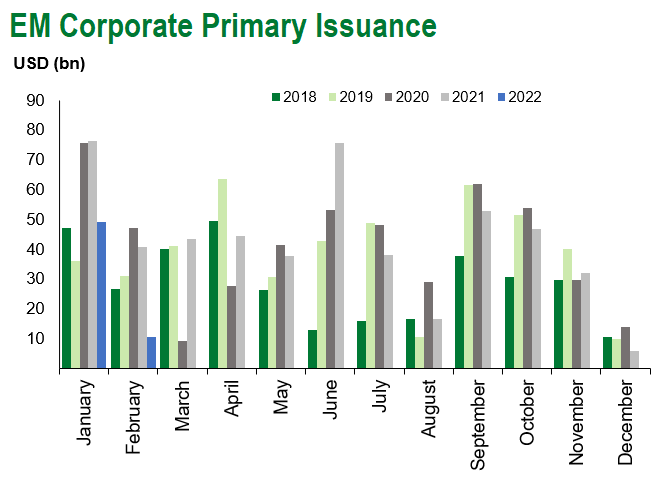
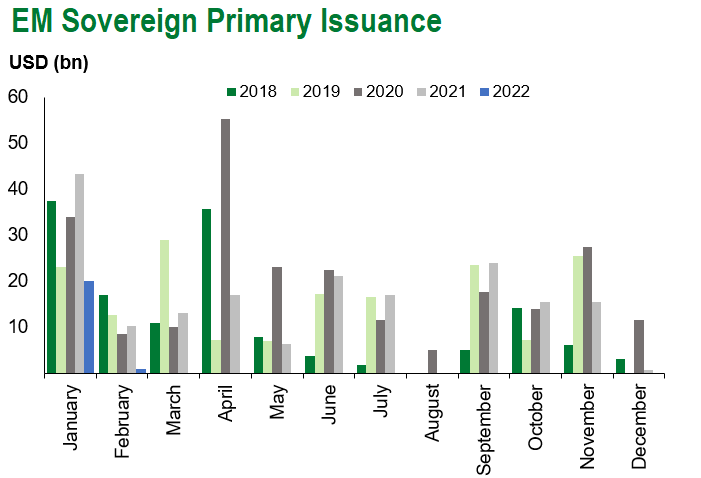
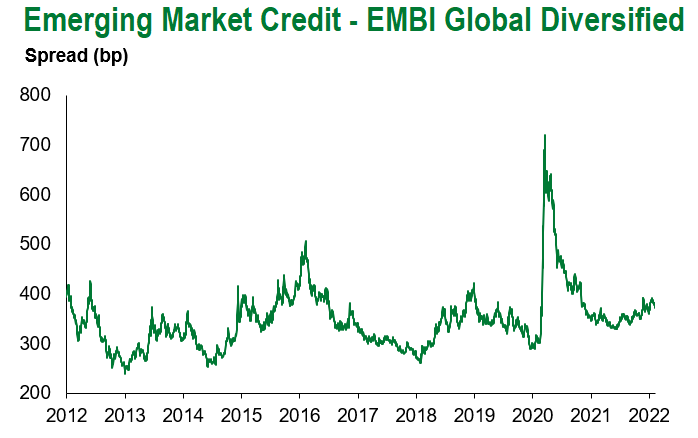
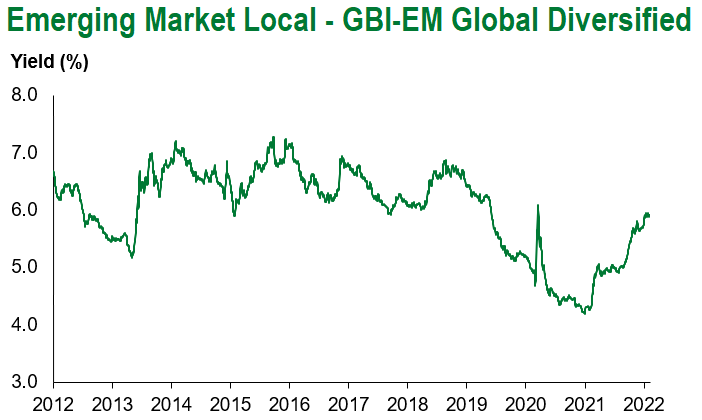
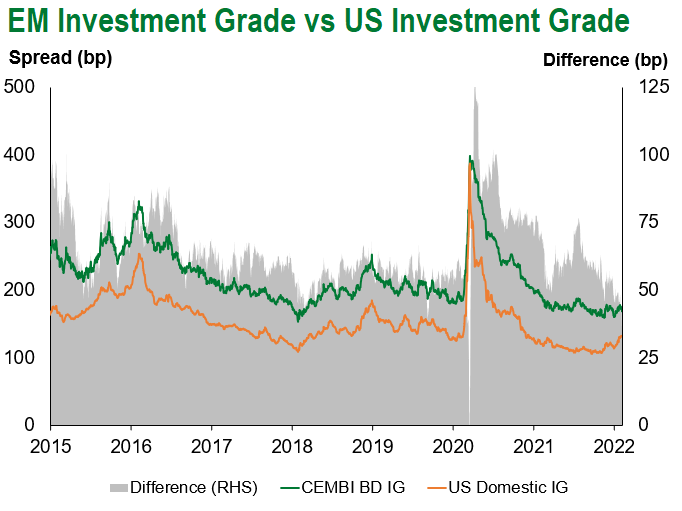
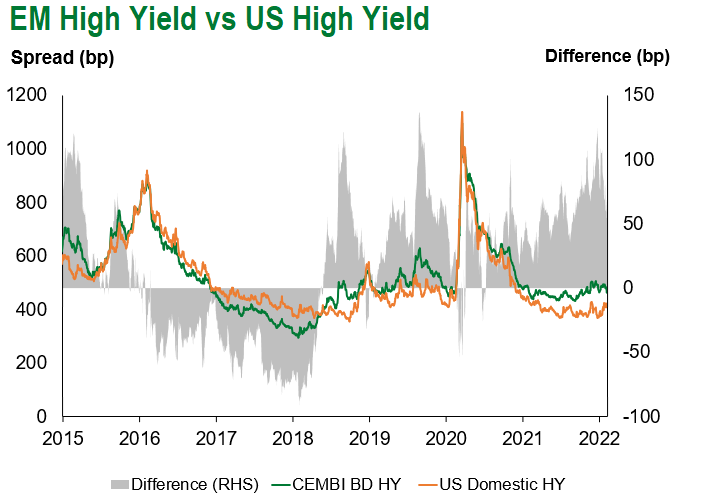
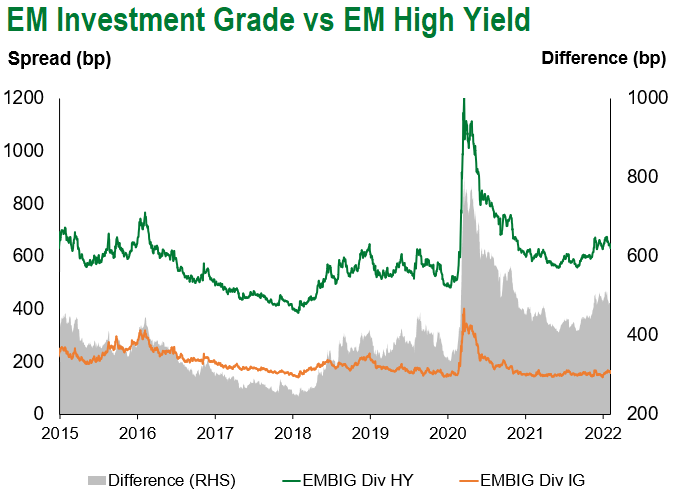
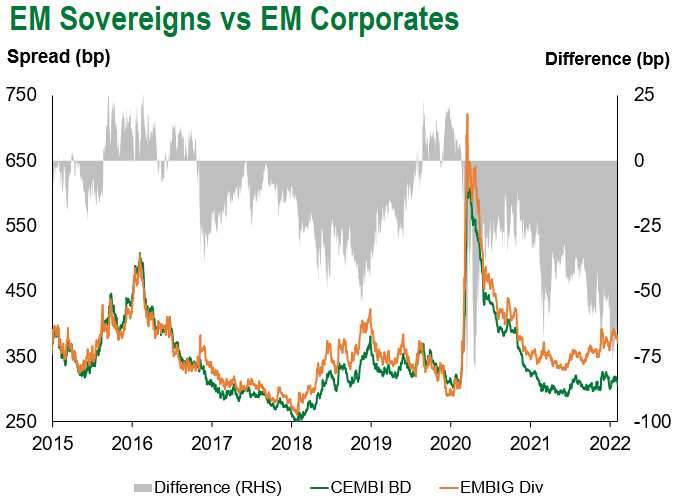
Emerging Markets Flows
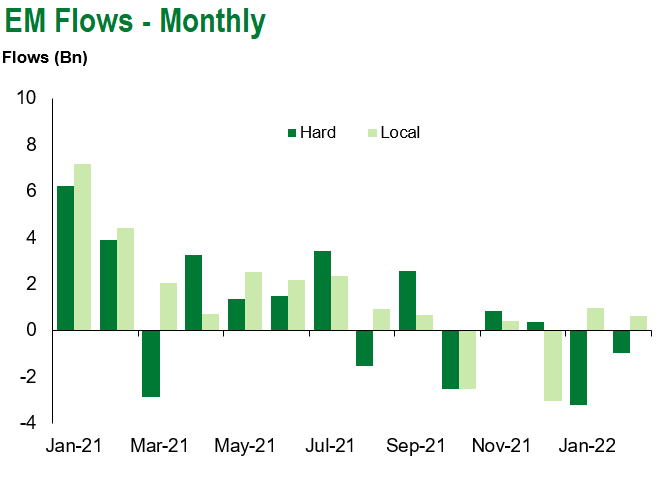
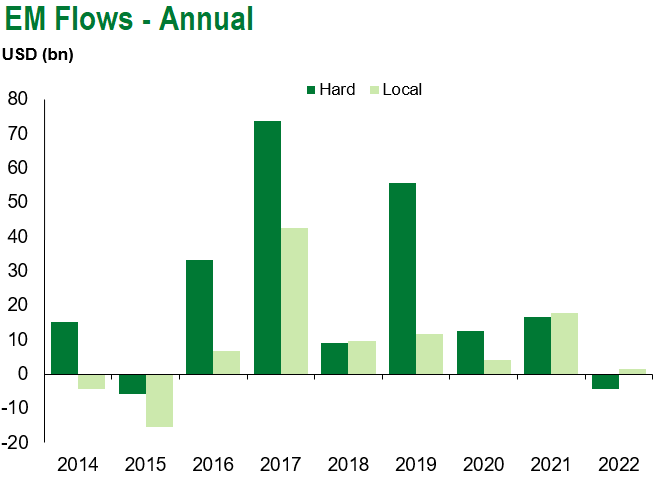
Source for graphs: Bloomberg, JPMorgan, Gramercy. As of February 11, 2022.
COVID Resources
Emerging Markets COVID-19 Case Summary
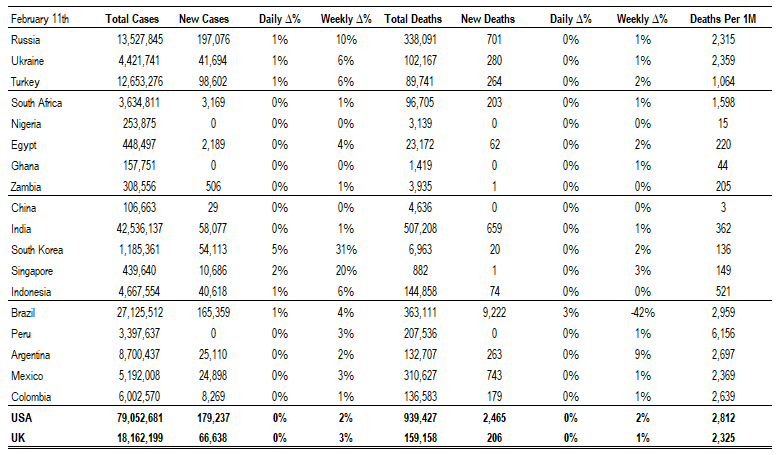
Source: Worldometer as of February 11, 2022.
Additional Crisis Resources:
Johns Hopkins COVID-19 Case Tracker
For questions, please contact:
Kathryn Exum, CFA ESG, Senior Vice President, Sovereign Research Analyst, [email protected]
Petar Atanasov, Senior Vice President, Sovereign Research Analyst, [email protected]
Tolu Alamutu, CFA, Senior Vice President, Corporate Research Analyst, [email protected]
James Barry, Vice President, Corporate Research Analyst, [email protected]
This document is for informational purposes only. The information presented is not intended to be relied upon as a forecast, research or investment advice, and is not a recommendation, offer or solicitation to buy or sell any securities or to adopt any investment strategy. Gramercy may have current investment positions in the securities or sovereigns mentioned above. The information and opinions contained in this paper are as of the date of initial publication, derived from proprietary and nonproprietary sources deemed by Gramercy to be reliable, are not necessarily all-inclusive and are not guaranteed as to accuracy. This paper may contain “forward-looking” information that is not purely historical in nature. Such information may include, among other things, projections and forecasts. There is no guarantee that any forecasts made will come to pass. Reliance upon information in this paper is at the sole discretion of the reader. You should not rely on this presentation as the basis upon which to make an investment decision. Investment involves risk. There can be no assurance that investment objectives will be achieved. Investors must be prepared to bear the risk of a total loss of their investment. These risks are often heightened for investments in emerging/developing markets or smaller capital markets. International investing involves risks, including risks related to foreign currency, limited liquidity, less government regulation, and the possibility of substantial volatility due to adverse political, economic or other developments. The information provided herein is neither tax nor legal advice. Investors should speak to their tax professional for specific information regarding their tax situation.